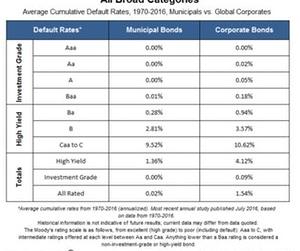How Secure Are Municipal Bonds?
Compared to a corporate bond with a similar credit rating, muni bonds are less likely to default while offering modest yields.
Oct. 11 2017, Updated 12:05 p.m. ET

VanEck
Muni Defaults and Bankruptcies Remain Quite Rare
Defaults in the muni space are still rarities when viewed in the context of the larger bond market, and global corporate in particular.
Out of the many thousands of rated muni bonds issued since 1970, there have been just 103 defaults. Of these, 72.8% were accounted for by competitive enterprises (revenue-supported healthcare, housing, and higher education), 20.4% by general governments, and just 6.8% by municipal utilities. Perhaps not surprisingly, most of the competitive enterprise defaults occurred during the period 2004-2008 as the housing sector became stressed.
Although the report observes that “the U.S. public finance sector is notable for infrequent defaults and extraordinary stability,” it does see changes on the horizon for the sector. The report goes on to state that “rating volatility, rating transition rates, cumulative default rates have all increased since 2007.” Because their revenues and expenditures are “delinked,” municipal governments have some flexibility when budgets become stressed. However, when push comes to shove, their first priority may not be re-paying bondholders. “A municipal government,” Moody’s observes, “will very likely choose to maintain basic services, pay teachers and policemen before bondholders.”
Market Realist
Benefits provided by muni bonds
In addition to the tax-exempt feature of municipal bonds (SHM) (ITM), another benefit of including muni bonds in a portfolio is its rare default rate. Compared to a corporate bond with a similar credit rating, muni bonds are less likely to default while offering modest yields.
Although muni bonds are generally less likely to default, this has not been the case in the last decade. Moody’s report stated that 103 defaults have occurred since 2007 and that five of them were by general governments.
Moody’s report noted that the most extensive municipal defaults in the last few years were Jefferson County, Alabama, in 2008; Detroit, Michigan, in 2013; and lastly, Puerto Rico’s default in 2016. The chart below shows the increase in the default frequency rate.
Moody’s report emphasized the fact that despite these recent defaults, the five-year municipal default rate since 2007 is 0.15%, compared to 6.92% for corporates during the same timeframe.
Muni bonds also offer a diversification benefit owing to their lower correlation with other asset classes, reducing the portfolio’s volatility. The chart below shows the ten-year correlation of municipal bonds with different asset classes.
Like every other investment, municipal bonds (PRB) also carry risk. Municipal bonds are susceptible to interest rate movements because its yield is inversely proportional to interest rate changes. In 2017, the possibility of more rate hikes by the Federal Reserve could have a damaging effect on muni bond yields.
Muni bonds are also susceptible to credit risk when the financial strength of a bond’s issuer is shaken or the credit rating of the bond changes. That said, muni bonds (MUB) (NYF) remain a suitable investment opportunity for tax-conscious investors who wish to earn high-quality tax-exempt income along with diversification benefits.
